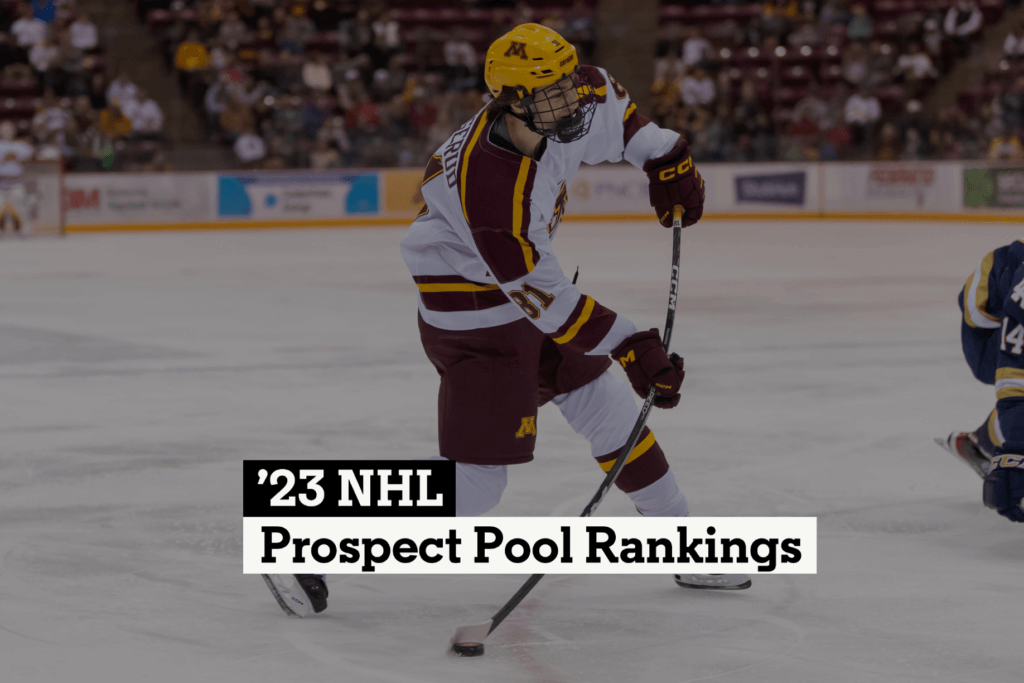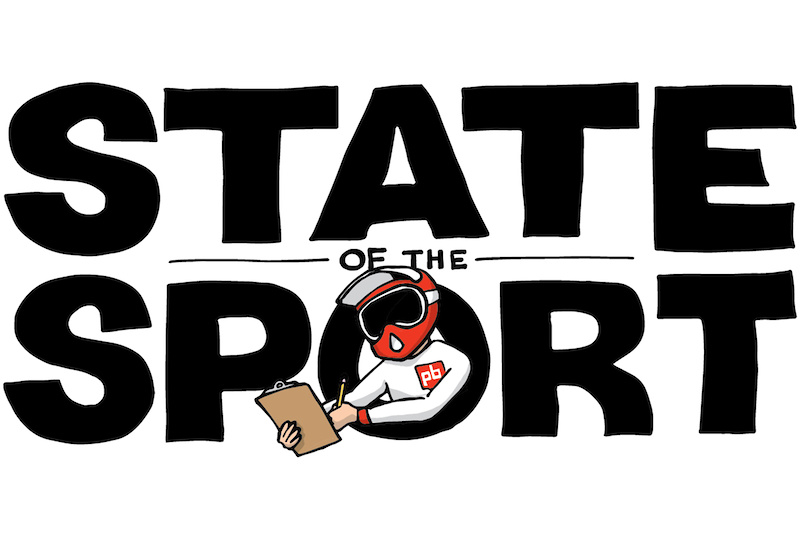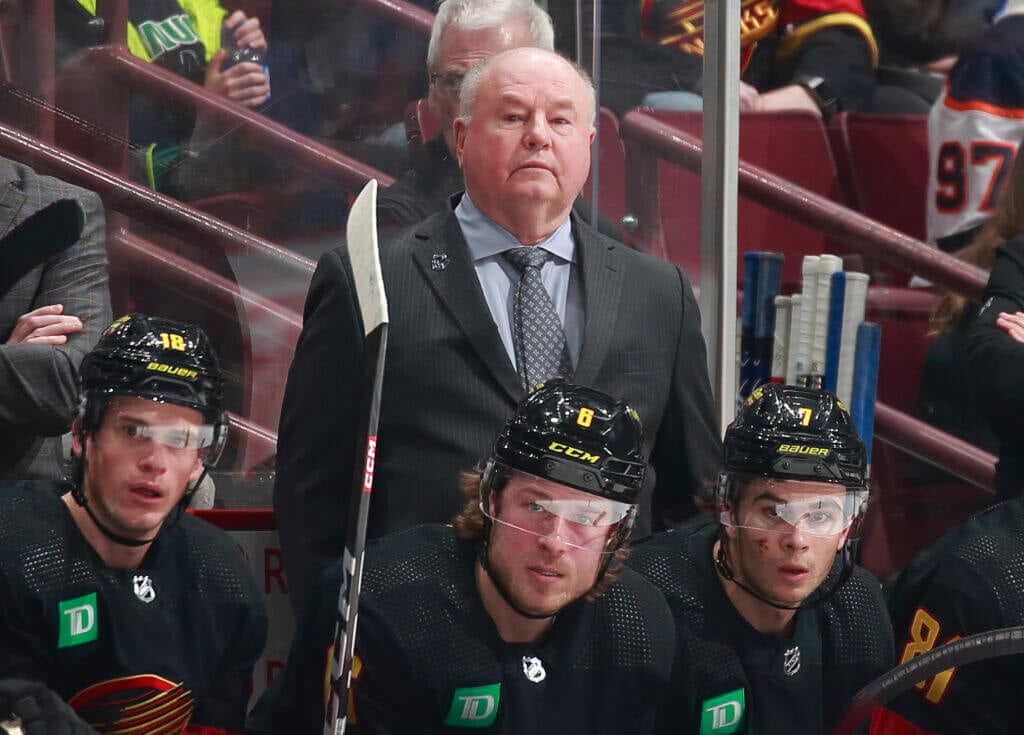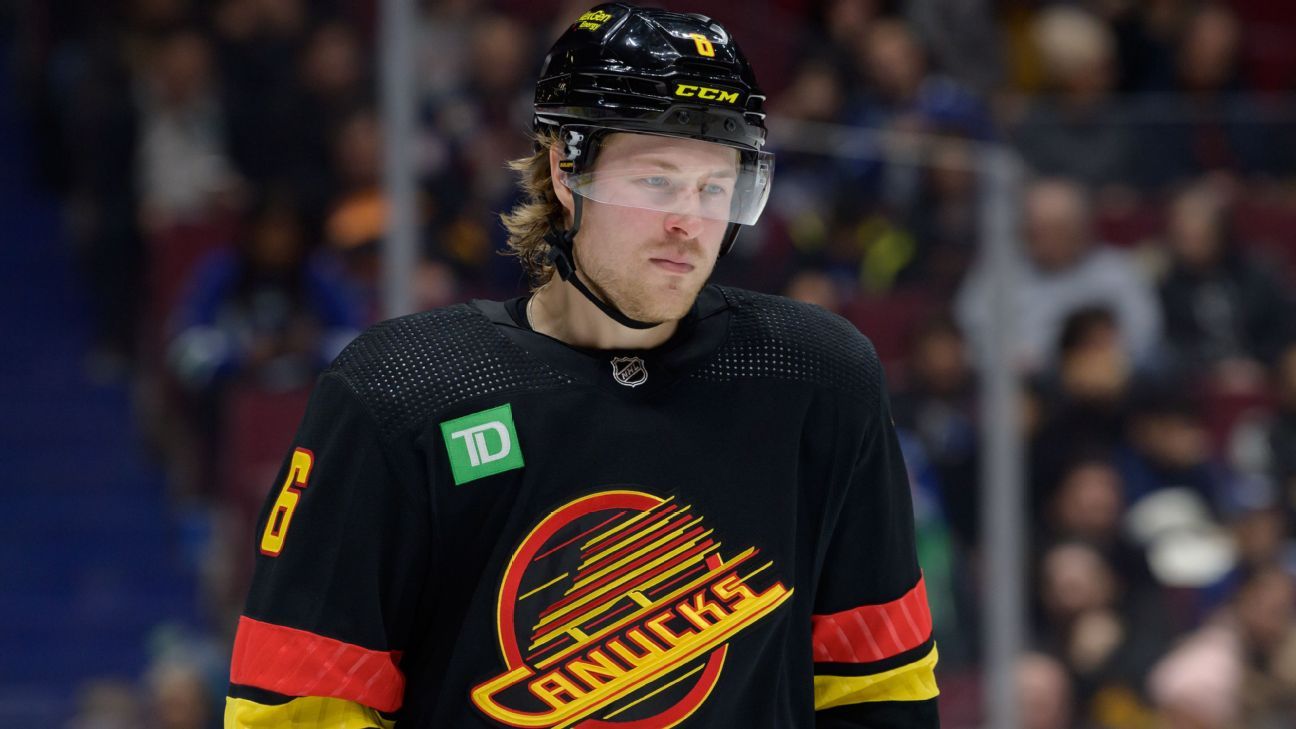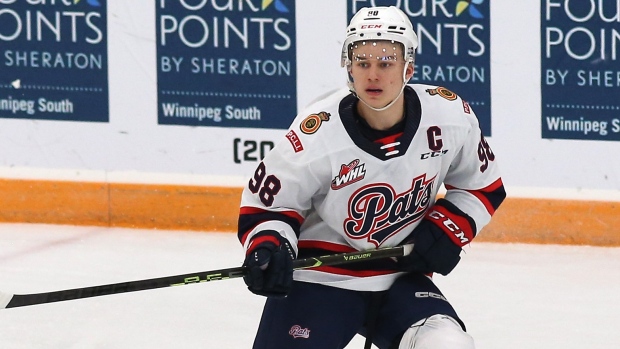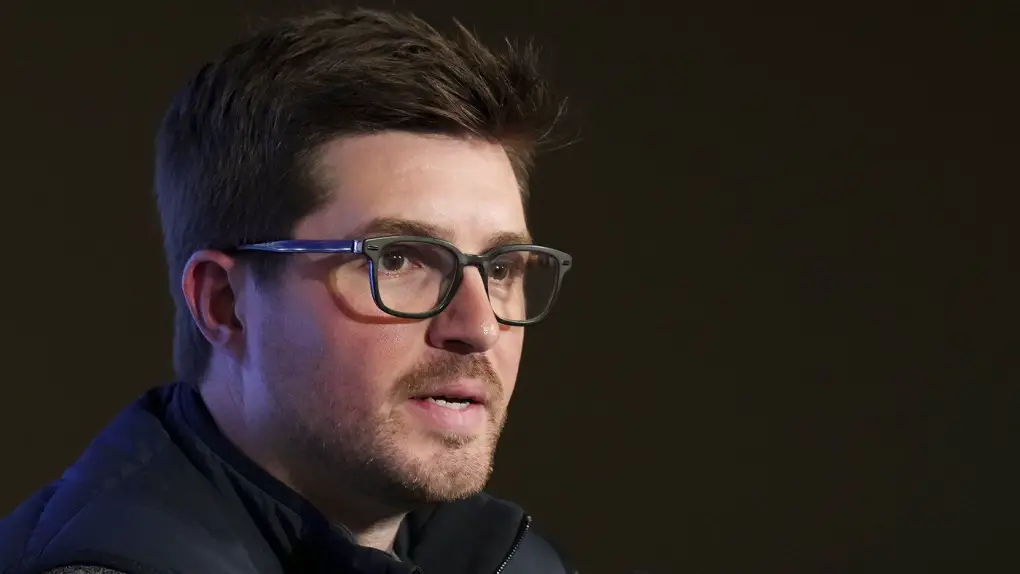Welcome to Scott Wheeler’s 2023 rankings of every NHL organization’s prospects. You can find the complete ranking and more information on the criteria here, as we count down daily from No. 32 to No. 1. The series, which includes in-depth evaluations and commentary from sources on nearly 500 prospects, runs from Jan. 9 to Feb. 8.
A strong 2022 draft class and good progress from several other prospects has helped the Blues move up five spots in this year’s ranking to climb from the league’s lower third to its middle third (I actually debated ranking them as high as 17th or 18th this year).
Their pool is highlighted by a core group of three forwards, a pair of potential solid backup goaltenders, and a handful of defensemen with depth upside.
2022 prospect pool rank: No. 24 (change: +5)
1. Jimmy Snuggerud, RW, 18 (University of Minnesota)
One of the hottest prospects in hockey and maybe the most impressive non-Adam Fantilli freshman in college hockey, Snuggerud has gone from B-plus prospect to A-grade prospect (or close) this season.
Every piece of his game has elevated this season. Plus-shot (had that already). Plus-skill. Good enough skater. Hard on pucks. Hunts pucks. Consistently impactful. Finding ways to release and move as soon as he has made his play so that he can get open for the next one again. It’s all there right now. Add in an extra step from a standstill and he’s on an exciting path.
We all should have seen it coming, maybe, too. When I polled last year’s U.S. NTDP players for their most underrated, he was basically the unanimous answer. Given that he played on a line with Logan Cooley and Cutter Gauthier, and a team that also featured other top forwards including speedy Frank Nazar and the likable Rutger McGroarty, him flying under the radar shouldn’t surprise.
Snuggerud is a well-rounded three-zone player with a versatile offensive game who works as hard as anyone out there. His head is always up and on a swivel, even in congested areas. He’s good below the goal line and makes a lot of low-to-high plays into the slot to find cutting teammates for chances. He sticks with the play and follows shots to the net to get to rebounds, playing a determined forechecking game. He’s got a dangerous one-timer and catch-and-release wrister but he doesn’t tunnel-vision for his shot, he sees the ice well, and he can make plays back against the grain. He’s got good hands, which help him make outside-in plays to beat defenders one-on-one more than he gets credit for. He uses space well and makes a lot of plays off of his backhand.
And on top of it all he’s also got a pro frame to build upon and a June birthday that gives him good runway. With the right development, there’s a top-six winger there.
2. Zachary Bolduc, LW, 19 (Quebec Remparts)
In the dozen games after he was cut by Hockey Canada, Bolduc registered an astonishing 14 goals (1.2 per game) and 26 points (2.2 per game) on 70 shots (5.8 per game). The league’s second-most productive player in points per game at the time of writing this behind only the Blue Jackets’ Jordan Dumais, Bolduc’s looking like a player who won QMJHL Rookie of the Year, was named the QMJHL’s top prospect in the 2021 draft, was drafted in the first round, and is on a path to the NHL. That’s particularly notable after he came through the pandemic, a pair of injuries, and an appendectomy in a short period of time.
He’s a kid whose skill and finesse have really impressed me in the last couple of seasons. He makes plays with such ease off the flank with the puck on his stick, especially off of cuts and as a passer. He has developed some real cleverness to his game, slipping away from checks and sliding pucks under sticks at speed. He’s also an underrated two-way winger who impresses on the penalty kill. And then he’s got a dangerous mid-range shot (which he gets off quickly and which also features a useful one-timer) and good overall skating which allows him to get good looks for himself and finish on them. I see a talented winger who can play on or off the puck effectively and create offense in a variety of ways. He’s got projectable second-line upside.
3. Jake Neighbours, LW, 20 (St. Louis Blues/Springfield Thunderbirds)
I’ve always been a little lower on Neighbours than the consensus, but he has slowly grown on me over the years (although I didn’t think he was at his best in the WHL playoffs or when I saw him in Saint John at the Memorial Cup last season). I also liked what I saw in a recent video session of his games in Springfield this year.
I still have modest reservations about his ability to develop into more than an impactful third-line winger (which is still a valuable player!), but he has shown skill to complement his tenacious, heavy, forechecking style. He finishes his checks, plays hard along the wall, and proved he can play a power-skill blend against his peers.
But he can also pound the one-timer from his off wing and there’s power to his wrister when he has time to let it go (though I’d like to see him work to quicken his release). And increasingly he’s imposing himself out there with the puck on his stick, attacking into that traffic with quicker hands, playing through contact, and using the attention he gets to facilitate into space.
Fans will love him for his pesky, talkative, almost-loud energy out there, too. But he also needs to continue to work on his skating (which is about average now) if he’s going to be as effective in the NHL as he is in junior. His sturdiness, approach, and above-average skill level remain his calling cards. But I think there’s a greater chance he tops out as a complementary piece at the NHL level than Snuggerud or Bolduc do. I don’t expect him to be a top-of-the-lineup guy.
4. Simon Robertsson, RW/LW, 19 (Skelleftea AIK)
A very tentative ranking, I think there’s a case for the next half dozen names after Robertsson on this list to slot ahead of him. For now, though, he gets the benefit of the doubt here on age and steady progress.
I’m slightly lower on Robertson today than I was on draft day though still. He ranked 30th on my final list and would slot as a second- or third-rounder today (though I’d still probably like him where the Blues got him at No. 71). I also probably would have played him a little more at this year’s world juniors than the Swedes did (I thought he was impressive on the PK, got some looks offensively, and skated well on a team that needed more from the guys higher in the lineup).
I’m not convinced he has a defining skill that will propel him into a scoring role at the NHL level, but it’s not hard to imagine him as a middle-six guy in a few years with the right patience. Robertsson is a play-driving, versatile winger with a nifty wrist shot release who pushes tempo through neutral ice with a compact stride.
He makes a lot of smart, aggressive plays inside the offensive zone, and can process the game at speed. When he gets the puck, he’s looking to take it at defenders and attack the inside (which he has begun to do more of in the SHL now too). I like the variety to his game, so that when the play to the middle isn’t there he can improvise (though I think he’s less creative today than I did in his draft year, which does mute some of his potential).
5. Joel Hofer, G, 22 (Springfield Thunderbirds)
It took Hofer some time to find the level in the AHL that he found in the WHL — and obviously for Canada at the world juniors — but he has gotten there this year, becoming a reliable game-to-game performer for Springfield. He’s also still young by goalie standards and his makeup still offers the promise that with consistent reps, he’s got NHL potential. He’s quick (though not explosive) in his net despite a 6-foot-5 frame, he’s got a good glove hand and sound technique, he challenges shooters directly and aggressively without pulling off his lines much, and he’s continuing to learn to hold his edges and remain compact. He’s still a little gangly (he’s listed at 180 pounds and adding strength and power is a must and has been a challenge) for sure but I’m not ready to bet against him finding his way into the NHL, even if that’s not as a starter or even a 1A (I’d project a 1B ceiling solid 2/3 floor).
6. Nikita Alexandrov, C, 22 (Springfield Thunderbirds)
Alexandrov’s a player whose game I often argued was going to translate better at the pro level than at the junior level. This year, we’ve seen that firsthand in his time in both the AHL and NHL as he has established himself as a well rounded AHL forward and begun to establish himself as a depth NHL one.
He was a top player in Charlottetown and showed real flashes against slightly older peers at the Traverse City Prospect Tournament, but he never found that star echelon at either. I’ve long viewed Alexandrov as a malleable player who can fit in up and down a lineup, play different styles, and function as effectively as a handler as he does as a heady, off-puck give-and-go type.
He’s not going to be a guy who has the puck a lot in the NHL but he’s got some creativity, skill and problem-solving sense. I like his shot from the home plate area as well, and he’s got a pro frame, decent hands, and B-level skills across the board. I think he’s going to stick in the NHL sooner rather than later, even if he tops out as more of a complementary piece than an impact one. There are some really positive early signs in his underlying results at the NHL so far too.
7. Noah Beck, RHD, 21 (Clarkson University)
Maybe the best story in the Blues’ pool in the last two seasons, Beck has turned some heads in the hockey world with his emergence in college hockey. The older brother of Flames prospect Jack Beck, Noah is a rangy 6-foot-4 defenseman who sits second on Clarkson in scoring and has proven he can influence play at both ends. He’s a strong two-way player in transition, where his smooth stride and comfort level carrying the puck up ice have both come a long way. He’s not a powerful player, but because his skating is a real asset and he’s got a good stick, his length helps keep play to the outside and disrupt opposing carriers.
He also doesn’t lack confidence in possession inside the offensive zone, where he’ll often swing off the point and around the perimeter to playmake. I expect he’ll get an NHL deal and if he stays on this track I won’t be surprised if he climbs through the AHL to the NHL. It doesn’t hurt that he’s a righty, either. I debated ranking him a couple of spots lower here, but repeat viewings just kept leaving me impressed.
Watch how No. 18’s skating helps him control play here (nice little saucer in the neutral zone and shot on the goal, too):
8. Tyler Tucker, LHD, 22 (Springfield Thunderbirds)
Some players are tricky to figure out but it doesn’t take long to realize what Tucker is. He’s a “what-you-see-is-what-you-get” player, for better and for worse. You can expect him to find his way into the box about once a game. You can expect him to take every opportunity available to him to knock someone over (whether along the boards, in transition, or in front of the net).
Between whistles, you can expect him to play on instinct (defensively and offensively). After the whistle, you can expect him to throw the first jab or helmet grab. He’s a throwback who can lack discipline in multiple areas but opposing players will tell you (and have told me) they don’t like playing against him.
He’s also a sturdy, heavy defender who is strong in battles and balanced on his skates, and who takes away space. And within that straightforward game, there is some skill. He’s got a heavy shot. He’ll outlet his fair share of pucks or make a play off of a pinch at the offensive-zone blue line. And his teams tend to do well when he’s on the ice. I think he’ll become a third-pairing guy at the next level if his feet, which are a little sluggish, can hold up. I don’t think he’ll be more than that though.
9. Michael Buchinger, LHD, 18 (Guelph Storm)
One of the best players on a Guelph team that didn’t meet expectations this season, Buchinger is a smooth-skating, smooth-passing two-way defenseman who breaks pucks out with a consistent first pass on outlets but also loves to jump into the rush to create offense with his feet as a trailer. He’s also got a hard and heavy shot (which we’ve seen more of this year). Defensively, he’s got a good stick that he leads with to disrupt carriers, and a physical edge that he’s comfortable falling back on as a backup to close out.
He surprised scouts with his vision inside the offensive zone and overall defensive polish as a rookie last season and has emerged as a point-per-game guy this year. I’m not settled on an NHL projection, but he’s the kind of player who feels like he’ll be solid AHL depth at minimum and I fully expect he’ll get signed at some point.
10. Vadim Zherenko, G, 21 (Springfield Thunderbirds)
After a fine season in Liiga a year ago followed excellent early career results at Russia’s lower levels, Zherenko has played quite well as the backup (so far) to Hofer in Springfield this season. Zherenko is a powerful, athletic 6-foot-4 goalie who moves aggressively to his spots to challenge shooters but also leverages his strength well to push back against the grain and make difficult recovery saves.
Over-movement can get him into trouble but he’s only 21 and as he continues to learn to stay square and react only when he has to, there may be some untapped potential to exploit. The ability is there and now it’s just about getting him continued reps in the AHL so that by the time his entry-level contract (which is only in its first year) is nearing its end, you can begin to test him in the NHL and decide on a second contract/greater role. If they stick with it with him, there’s some promise.
11. Aleksanteri Kaskimaki, C, 18 (HIFK)
One of the top forwards in Finland’s junior league last year, Kaskimaki’s post-draft season has been a bit of a slow one as he has struggled to find his spot in the pro team and national team’s lineups (though it was a credit to him that he made the Finnish world junior team at 18 and he’ll be eligible to return next year in Gothenburg). Last year, in junior, he can get what he wants with the puck on his stick and would regularly rack up gaudy shot totals. He also played on Finland’s top line (though he was definitely its third fiddle) at U18 worlds.
His hands can flash. When he gets an opportunity (whether that’s being left alone in the slot or a defender making a mistake), he’s got the skill to make plays. He’s strong for his size and works hard to be at the center of the action. But he’s also one of those classic case studies where he’s really going to have to hit a lot of checkpoints to become an offensive case-use player and he’s probably not going to be a role player (even though he has been used in defensive/penalty killing minutes at times at lower levels). Worth a keen watchful eye, at minimum. He’s got lots of time, too.
12. Matt Kessel, RHD, 22 (Springfield Thunderbirds)
Kessel’s a player I watched a great deal of late two seasons ago when I was, coincidentally, doing a deep dive on his D partner, Zac Jones (New York Rangers) en-route to their national championship together. He had an excellent sophomore season that year alongside Jones, had a strong junior year on a lesser team, and has looked fine though unremarkable in his first full pro season in the AHL.
I’ve got time for him. Though his production has never popped, Kessel’s not the reserved, safety valve type you might expect. In fact, he plays an aggressive, engaged, active, involved style that looks to force the issue and join the rush in transition. And considering his 6-foot-3 frame, his physicality, his handedness, and his excellent stick defensively, he’s more interesting than his statistical profile might suggest. He’s got a hard point shot to fall back on as at least one element to complement his willingness to attack as well. He has pulled back on the reins a little at the pro level, but I’ll be interested to see if he can become a decent No. 5-7 defenseman. He may just top out as a good AHL defenseman, but there’s more than meets the eye with Kessel.
13. Arseni Koromyslov, LHD, 19 (SKA St. Petersburg)
One of the youngest defensemen currently playing in the KHL, Koromyslov was a name prospect in Russia coming up that I just couldn’t wrap my head around liking as much as others seemed to. This year, I’ve softened on that, and have developed more of an appreciation for his efficiency and effectiveness in all three zones. He’s a 6-foot-2 defenseman with good four-way mobility that allows him to escape the first forechecker and headman pucks, defend and help out in transition in the neutral zone, and then subtly steer play inside the offensive zone through calculated decision-making with the puck and moving off of it. His game doesn’t grab you, but he plays a modern style well and might develop into a depth defenseman in time.
14. Marc-Andre Gaudet, LHD, 19 (Sherbrooke Phoenix)
A late-blooming defenseman who has emerged as a top two-way defenseman in the QMJHL, Gaudet worked his way onto this list with a strong post-draft season to start the year in Chicoutimi and more recently after a trade to the title-contending Phoenix. He’s an athletic 6-foot-3 defenseman who skates well, plays tight gaps to take away time and space from opposing carriers, and likes to involve himself in the offense as a tertiary shooting threat (it pops off of his stick). I wouldn’t say he’s a natural playmaker per se, but he can play the length of the ice and has come along quickly over the last two seasons. I’m intrigued at the very least.
15. Tanner Dickinson, C, 20 (Springfield Thunderbirds)
After losing the 2020-21 season to the pandemic, Dickinson broke his femur in late January of the 2021-22 season and hasn’t played since. It’s a shame, too, because he’d had a really positive first half with the Greyhounds, hovering around the OHL’s top 10 in scoring and points per game while continuing to drive possession and play reliably off the puck. He picks up his stick into a pitchfork stance a little too much but his skating is an asset. I’ve had multiple people in the OHL compliment it, and he should be able to add power to his otherwise good technique as he continues to get stronger (which has been and will be a focus for him).
He pushes pace and makes plays in transition, he’s got good offensive instincts, he trusts those instincts, and I like the way he sees the ice. He’ll slow the game down and take what’s given in one sequence in control and then stay one step ahead of the play with a quick one-touch pass the next. If he can fill out more (he’s listed as 6-foot, 170 pounds), he has tools that could serve him well at the pro level. He may have lost too much time to get there, but I think he would have been on this list had he been healthy so I decided to keep him on it for now.
The Tiers
Each of my prospect pool rankings will be broken down into team-specific tiers in order to give you a better sense of the talent proximity from one player to the next (a gap which is sometimes minute and in other cases quite pronounced).
The Blues’ prospect pool breaks down into three tiers divided as such: 1-3, 4-12, 13-15. I also considered unranked forwards Mathias Laferriere and Keean Washkurak, defensemen Leo Loof and Tyson Galloway, and goaltender Will Cranley.
|
Rank
|
Player
|
Pos.
|
Age
|
Team
|
|---|---|---|---|---|
|
1 |
Jimmy Snuggerud |
RW |
18 |
U. of Minnesota |
|
2 |
Zachary Bolduc |
LW |
19 |
Quebec |
|
3 |
Jake Neighbours |
LW |
20 |
Springfield |
|
4 |
Simon Robertsson |
RW/LW |
19 |
Skelleftea |
|
5 |
Joel Hofer |
G |
22 |
Springfield |
|
6 |
Nikita Alexandrov |
C |
22 |
Springfield |
|
7 |
Noah Beck |
RHD |
21 |
Clarkson |
|
8 |
Tyler Tucker |
LHD |
22 |
Springfield |
|
9 |
Michael Buchinger |
LHD |
18 |
Guelph |
|
10 |
Vadim Zherenko |
G |
21 |
Springfield |
|
11 |
Aleksanteri Kaskimaki |
C |
18 |
HIFK |
|
12 |
Matt Kessel |
RHD |
22 |
Springfield |
|
13 |
Arseni Koromyslov |
LHD |
19 |
St. Petersburg |
|
14 |
Marc-Andre Gaudet |
LHD |
19 |
Sherbrooke |
|
15 |
Tanner Dickinson |
C |
20 |
Springfield |
(Photo of Jimmy Snuggerud courtesy of the University of Minnesota)
#NHL #prospect #pool #rankings #Louis #Blues
